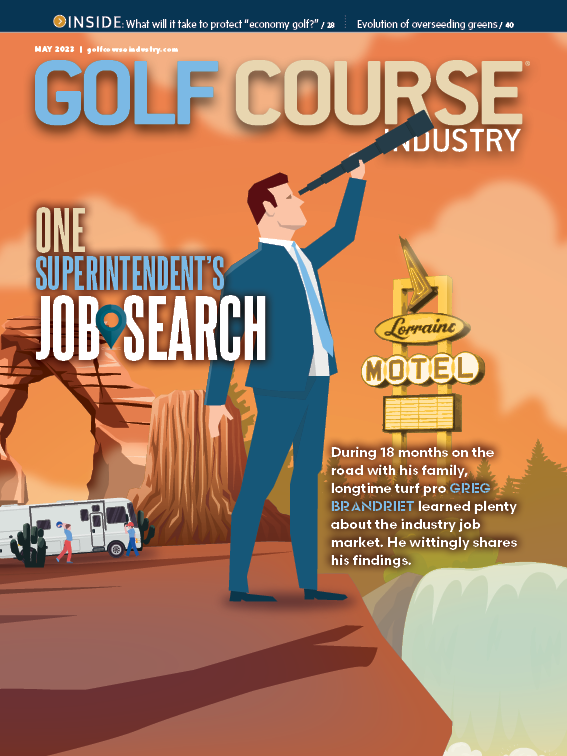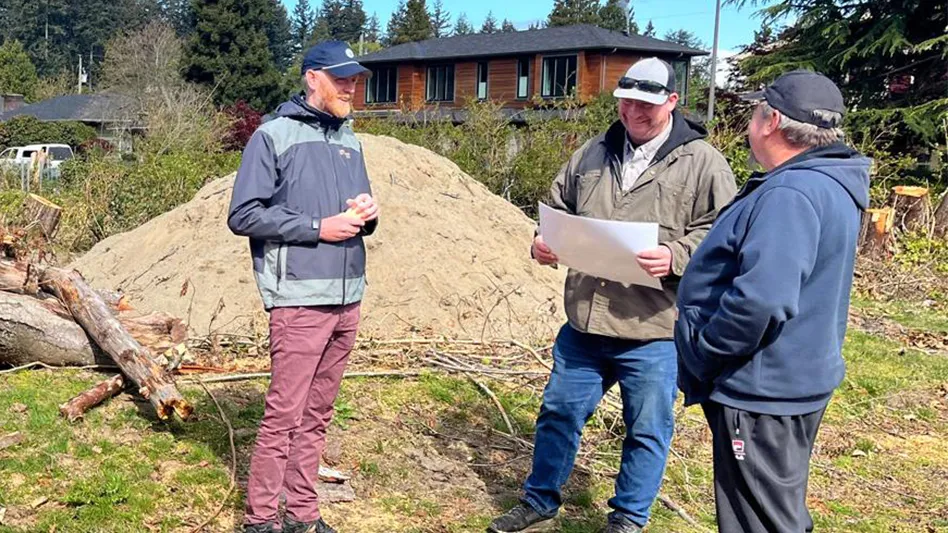
Charles Blair Macdonald was born in Ontario, raised in Chicago, attended university at St Andrews and studied under Old Tom Morris in the early 1870s. Macdonald became a well-known golf architect and is widely believed to have designed the first 18-hole golf course in the United States, Chicago Golf Club.
In 2023, one of Macdonald’s descendants, Harrison Young, took a course through the Virginia Tech School of Turfgrass Ecology and Management to study to become a certified turf professional along with John Clintsman, Jarrod Taylor and more than 80 other people nationwide.
Organized by Dr. Mike Goatley, Virginia Tech Turfgrass extension specialist, the objective was for students to learn more about turf management through studying plant and pest identification, turfgrass mathematics, soil chemistry, plant physiology, cultural management practices and more. Fanatical discourse about Kentucky and Ohio State men’s basketball was shared live, often and for free.
One question got a laugh during the final Zoom review session: “What are we going to do on Wednesday nights?”
Clintsman is the director of grounds at Ensworth, a private school in Nashville, Tennessee, where he oversees 150 acres, including 12 natural playing fields. He recently received the Sports Field Management Association President’s Award for Leadership. Clintsman enjoyed participating in the Virginia Tech course. “I made a lot of new friends,” he says. “We have all been encouraging one another and have been each other’s biggest cheerleaders.”
The class began in late November with assigned reading and videos to review, along with weekly pre-tests and post-tests. Every Wednesday (excluding holiday weeks), there was a two-hour Zoom meeting to cover the material and listen to a variety of industry speakers, including National Turfgrass Federation President Kevin Morris and DLF USA’s Dr. Leah Brilman.

Zoom meetings were recorded and available for additional viewings, helpful for anyone unable to attend on a particular Wednesday or simply to revisit the material. The entire course is designed to be as flexible as possible so that motivated individuals can have a chance to further their education on their own time, or through designated hours while at work.
Though everyone in class was there to learn more about turf management, the students had a diverse range of experience, both in level and perspective. Entities represented included golf courses, sports field turf management, national parks, schools, municipal recreational facilities and others (like curious writers). The style of the course was casual and engaging.
“I really wanted to sit under the Dr. Goatley learning tree,” Clintsman says. “With Dr. Goatley and Dr. Dan Sandor, you knew you were going to get something out of it. They are not going to waste your time because they are not going to waste their time. I did the course because I love what we do and I love learning more about what we do.”
Taylor, the superintendent at Willowbrook Golf Course, in Breaks, Virginia, agrees. “I like to get as much knowledge as I can. That is only going to help the golf course and me, too,” he says. “I learned a tremendous amount. Any question I had, the instructors would respond quickly and thoroughly.”
Formerly a gunner on a helicopter and a mechanic with the Marines, Taylor has helped Willowbrook become profitable during his tenure over the last two years. He is the superintendent and the mechanic, and he acknowledges that maintaining a course is a team effort. The class helped him specifically to identify problematic weeds, learn about pesky mole crickets and evaluate different approaches to fertilizing. Willowbrook lets teens play for free. It’s a public course and Taylor is happy to have them there.
“I would highly recommend anyone taking the class,” he says. “I could do everything from home. If I had to go in person that would be hard because I have work and my kids, and, of course, they play ball.”

Finding the right combination of in-person and distance learning, where the student is committed and comfortable, is critical for successful completion of any class.
Goatley understands this and began the course in 2020 with the following goals …
- Create an intensive, comprehensive introductory teaching-and-testing program during winter months for people with little or no formal education in turfgrass science (assignments were designed with maximum flexibility).
- Introduce the Virginia Tech turf team through weekly Zoom meetings where participants discover that these dedicated scientists enjoy helping others and are fun to spend time with (side note: they are also musically gifted— iykyk).
- Through guest speakers, create exposure and understanding of various industry segments.
- Establish a meaningful, highly accessible certification program.
- Empower newly minted CTPs to grow their expertise and professionalism in this industry, opening the doors for advancement and additional opportunities.
The program is not designed to compete with certifications from the GCSAA or SFMA. Being in the Transition Zone, research and findings on cool- and warm-season grasses are discussed with authority. Program participation has included students from 13 states and Puerto Rico. “We hope to continue to enroll more students from outside the Mid-Atlantic in addition to students nearby,” Goatley says. “They learn from us, but we learn from them, too.”
For superintendents and other industry leaders, the opportunity is there to invest in workers who might otherwise not be able to afford education. The entire course cost just north of $500 and there is a conditional money-back guarantee. Investing in someone and helping them grow can be just the push they need to turn their seasonal job into a career.
This model of learning is working, due in no small part to the efforts of the team at Virginia Tech. Sandor and Travis Roberson, who is pursuing his Ph.D., led most of the sessions, and alongside Goatley, they have been nearly constantly available. Through their presence on the discussion board, responding to personal emails and talking with many members of the class on the phone, at conferences or through site visits, it’s clear how much they care. There’s no substitute for that level of attention and students learn more and are highly motivated in that environment.

As a team leader, making this an option for workers in the “off-season” for colder climates may keep people engaged and contribute to retention. It’s rejuvenating to learn new things or reinforce core concepts for more established workers. The network of peers helps too. Passing quizzes every week creates a buzz and positively reinforces the learning taking place. After a few weeks, students can look back and realize how much they have accomplished.
This course, and others like it, is a way to simultaneously invest in your team and elevate the industry. Many students were sponsored by their employers for the class, but some individuals were pursuing accreditation on their own. Diverse backgrounds provided a platform for meaningful class discussions.

Young never had any formal turf training. As the director of racing surfaces at Colonial Downs, he oversees the Secretariat Turf Course, which is covered in Bermudagrass and is the widest grass racing surface in the United States. “We are a little gem in Virginia,” Young says, “but how can we attract national attention? By providing a safe, consistent surface where horses can perform and excel.”
He enrolled in the course to learn more about “how to care for a track where horses weighing 1,400 pounds are putting 2,500 pounds of pressure into the turf with every stride.”
“I needed to learn more about root systems, turf cultural practices and technology,” Young adds. “I needed to understand plant response to encourage recovery in a short timeframe. If the turf performance improves, so does the experience.” Sounds familiar, right?
Young knows the accreditation of being a CTP will help him with industry relationships and he wants to motivate others to transition from starting positions to those with more responsibility. He is speaking at high schools, hosting site visits, and embracing the idea that gleaning knowledge is a way to shift career trajectories. Young, Clintsman and Taylor recognize that labor is a challenge, people are happier when they’re learning, and it’s important that the people they manage daily are as productive as possible.
For Charles Blair Macdonald, whether acquiring new skills on site with Old Tom Morris or through studying at university, his education was clearly influential. Education matters. It changes lives. Make the most of any form of learning for your staff, yourself and the properties for which you care.
“The next CTP class will begin on November 5, 2023,” Goatley says. “The education, the outreach and the chance to engage with folks in the industry is what we are all about.”

Explore the May 2023 Issue
Check out more from this issue and find you next story to read.





